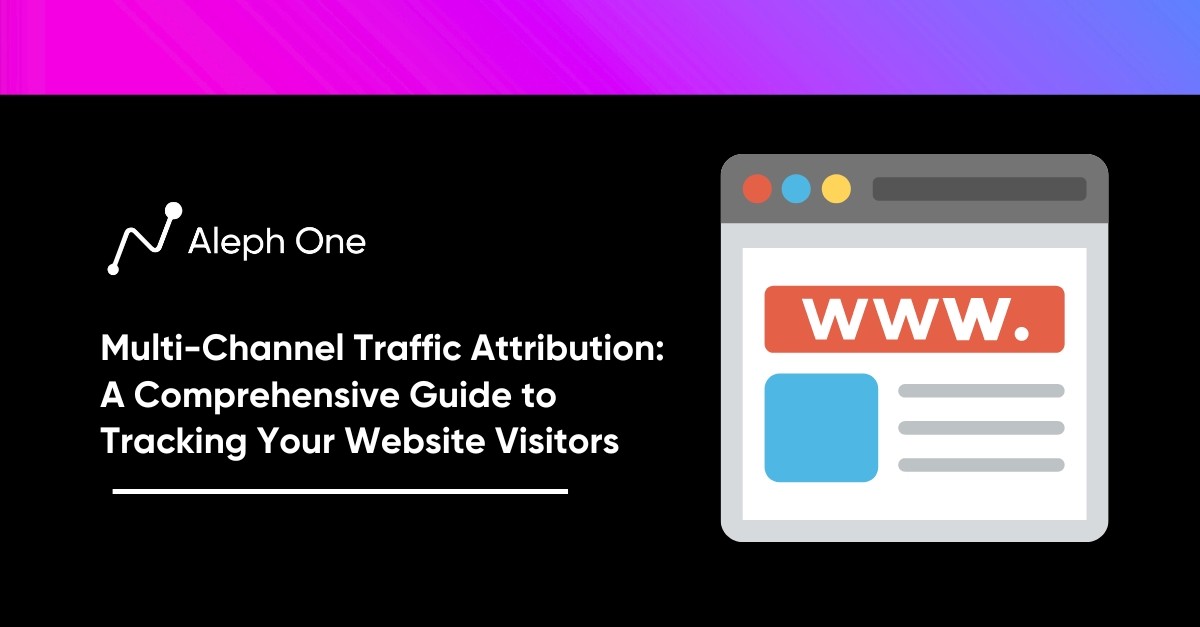Let’s work together to build something amazing. Share your project details and our team will reply to figure out the next steps to your success.

Understanding the journey of your website visitors and accurately attributing the traffic to various marketing channels is the key to unlocking growth and maximizing your online presence in today’s digital landscape. Gone are the days of relying solely on last-click attribution models, where the true impact of your marketing efforts remains hidden. It’s time to dive into the world of multi-channel traffic attribution and discover the power of tracking and analyzing every touchpoint along the customer’s path. This comprehensive guide identifies the knowledge and strategies you need to master traffic attribution like a seasoned pro.

The Problem of Egocentric Attribution Models
The last-click attribution model is an egocentric approach that needs to account for the influence of other touchpoints in the conversion journey. This model attributes 100% of the conversion credit to the last channel a customer interacted with before purchasing or converting. While simple to implement, the last-click model ignores the impact of all other marketing channels that contributed to the sale.
Ignoring the Impact of Multiple Touchpoints
According to a study by Google, 70% of customers engage with a brand on more than one channel before converting. The last-click model disregards these other interactions and disproportionately favors channels more likely to be last in the conversion path, like email marketing or paid search ads. This can negatively impact marketing optimization and budget allocation.
Disproportionate Credit Allocation in Last-Click Attribution
For example, a customer may discover a product on social media, research it on the company website, receive a retargeting ad, and convert it to an email campaign. The last-click model would attribute the full conversion value to email, even though the initial interest was sparked on social media and the company website. As a result, marketers may end up overspending on email marketing and underspending on social media or the website.
The Need for Holistic Attribution
The last-click attribution model provides an egocentric view of the customer journey that can mislead marketers into making poor optimization and budgeting decisions. While easy to understand, this model needs to account for the holistic impact of marketing channels on conversions. Multi-touch attribution models were developed to solve these shortcomings by distributing conversion credit across all touchpoints contributing to the sale. These models provide a more customer-centric view of the path to purchase and help marketers make better data-driven decisions.
A Customer-Centric Perspective
The last-click attribution model is an egocentric approach that needs to account for the influence of other touchpoints in the conversion journey. This can negatively impact marketing optimization and budget allocation, highlighting the need for multi-touch attribution models. Multi-touch models distribute conversion credit across all touchpoints, providing a more holistic view of the customer journey.
The Rise of Multi-Touch Attribution
As the customer journey has become increasingly complex with the rise of digital marketing channels, the limitations of last-click attribution models have become more apparent. Customers today interact with brands across many touchpoints—social media, display ads, email, search, and more—before converting to a website. Last-click models fail to account for the influence of these other interactions, leading to inaccurate insights and suboptimal marketing decisions.
Introducing the Multi-Touch Attribution Models
Multi-touch attribution models have emerged to provide a more comprehensive view of the customer journey. Multi-touch attribution, or MTA, aims to distribute conversion credit across the various touchpoints contributing to a sale or lead. Instead of attributing 100% of the credit to a single touchpoint like the last ad click, MTA models use rules or algorithms to allocate credit to multiple touchpoints based on their estimated impact and influence.
Customizing Credit Allocation
For example, a time decay model may allocate 40% credit to the first touchpoint, 30% to the last, and distribute the remaining 30% across other middle touchpoints. A linear model splits credit evenly across all touchpoints. Data-driven models analyze touchpoint data to determine customized credit allocations for each channel. These models provide a more accurate picture of how your marketing activities drive conversions.
The key benefits of multi-touch attribution include:
- Understanding the customer journey. MTA provides insights into the path to purchase and how customers interact with your brand across channels. This helps identify opportunities to optimize the experience.
- Optimizing marketing mix. By understanding the influence of each channel, you can allocate budgets more effectively and make better decisions about which channels to invest in.
- Data-driven decisions. MTA models are based on actual customer behavior data, not assumptions. This leads to attribution insights grounded in facts.
- Improved ROI. More accurate conversion credit attribution can reveal overperforming or underperforming channels. You can then adjust budgets and tactics to improve overall marketing ROI.
Multi-touch attribution aims to solve the shortcomings of last-click models by providing a holistic view of how all touchpoints work together to drive conversions. With the increasing complexity of the customer journey, MTA has become crucial for gaining data-driven insights to optimize marketing performance.
An Overview of Google Analytics Attribution Modeling
Google Analytics provides robust tools for implementing attribution modeling and understanding how your marketing channels influence conversions. Google Analytics offers three data-driven attribution models:
- Time Decay: This model gives more credit to the touchpoints that occurred closer in time to the conversion. It is useful when clear paths to conversion and interactions close to the sale strongly influence the final decision.
- Linear: This model distributes conversion credit evenly across all touchpoints in the conversion path. It assumes all interactions are equally valuable. This model works best when multiple channels are used together and work equally to drive conversions.
- Position Based: This model assigns conversion credit based on the position of the interaction in the path to conversion. For example, 40% credit is given to the first and last touchpoints, and the remaining 20% is distributed evenly across the middle touchpoints. This model works well when the first and last interactions in the journey are most influential.
Attribution modeling does require time and resources to implement properly. But with Google Analytics’ robust and customizable tools, you can gain data-driven insights into how your marketing channels work together to drive conversions. By understanding your customers’ journey and allocating budget based on influence, you set your marketing strategy up for success.
How to Choose an Attribution Model
With several attribution models to choose from, how do you determine which one is right for your organization? There are a few key factors to consider:
1. Organizational Goals
Your attribution model should align with your company’s key objectives. A linear or time decay model may be suitable for optimizing long-term customer lifetime value. If the goal is maximizing short-term conversions, a last-click model could work. First, define priorities, then choose a model to support them.
2. Customer Journey Complexity
The more complex your customer journeys are, the more you need an attribution model that accounts for multiple touchpoints. A last-click model may suffice if you have a short, simple journey with one or two touchpoints. A data-driven or algorithmic model is probably needed to distribute credit accurately for longer omnichannel journeys. Assess how your audiences interact with your brand to determine the appropriate level of attribution complexity.
3. Data Quality and Availability
The data you have available significantly impacts your choice of attribution model. A simple model like last-click or first-click may be your only option if you can only access limited data from a few channels. Robust, cross-channel data allows for the use of more advanced attribution models. Review what data you have and what additional data may need to be collected to enable the desired model.
4. Available Tools and Expertise
The tools and skills your organization possesses also factor into the attribution model you can build and maintain. If you only have an essential web analytics tool, you may be limited to its native attribution models. Advanced tools with machine learning capabilities open up more sophisticated, customized options. And your team needs the expertise to configure, evaluate, and optimize the model properly. Choose a model that aligns with your resources and capabilities.
By analyzing these factors, you can determine the optimal attribution model for your needs. No model is inherently right or wrong—it depends entirely on your unique situation and objectives. Focus on starting simple, then evolving your model over time as your data, tools, and marketing strategies advance. The suitable model will give you valuable insights to improve customer experiences and business results.
A Look into the Future of Marketing Attribution
Marketing attribution continues to evolve as new technologies and data sources emerge. Here are some of the trends shaping the future of attribution:
Machine Learning and AI
The use of machine learning and AI for attribution modeling is growing. Rather than relying on predefined rules, machine learning algorithms can analyze huge volumes of customer data to detect complex patterns and automatically optimize attribution models. AI and machine learning can help uncover insights that humans would otherwise miss. Companies like Google, Adobe, and Nielsen already offer AI-powered attribution solutions.
People-Based Attribution
People-based attribution is on the rise. In today’s multi-device world, cookies, and device IDs are becoming less reliable as identifiers. People-based attribution matches customer data from different sources to create a unified profile of each individual. This provides a more accurate view of the customer journey across devices and channels. However, people-based attribution also raises privacy concerns that companies must address.
Enhancing Attribution Insights and New Data Sources
New data sources are enhancing attribution insights. Emerging data sources from IoT devices, offline channels, and third-party partners provide a more holistic view of the customer journey. For example, beacons and RFID tags can track customer behavior in physical stores. Integrating this data with digital touchpoints enables attribution across online and offline channels. However, organizations must ensure proper data governance and quality when combining data from multiple sources.
To prepare for the future of attribution, organizations can:
- Invest in machine learning and AI to optimize attribution models: Work with vendors that provide AI-powered attribution or build in-house data science teams.
- Implement people-based attribution: Match customer data from different sources to enable attribution at the individual level while maintaining high privacy standards.
- Explore new data sources to enhance insights: Identify emerging data sources within and outside the organization that can provide a complete view of the customer journey. Ensure proper data hygiene before integrating new data into attribution models.
- Focus on data governance and quality: Data quality is critical with multiple data sources and complex attribution models. Establish processes to validate, cleanse and unify data from different sources to enable accurate attribution insights.
- Continuously test and optimize: Attribution modeling is an iterative process. Regularly test the performance of different models and make improvements to achieve the best results. Stay on the cutting edge of new technologies and trends.
The future of marketing attribution is bright. By leveraging new technologies and data sources, organizations can better understand how customers interact with their brands and optimize their marketing investments. However, successfully implementing these emerging attribution capabilities requires a focus on data quality, governance, privacy, and continuous optimization.
FAQ
Considering the limitations of the last-click attribution model, how could organizations transition from it to multi-touch attribution models without risking their current progress?
Transitioning from the last-click attribution model to multi-touch models requires a well thought out approach and gradual implementation. Organizations can start by running both models simultaneously to minimize the risk to current progress. While the last-click model continues to guide immediate decisions, businesses can collect and analyze data under the multi-touch model. As they gain insights and confidence in the multi-touch model’s results, they can slowly decrease their dependence on the last-click model, eventually replacing it completely.
How can a business accurately determine its customer journey complexity to choose the right attribution model?
Determining customer journey complexity involves tracking consumer interactions across multiple platforms. This could include monitoring engagement on social media, website visits, email campaigns, and even offline interactions such as store visits or calls to the customer service department. By capturing and analyzing this data, an organization can understand the average number of touchpoints involved before conversion and the relevance of each of these touchpoints. Analytics tools such as Google Analytics and customer relationship management (CRM) systems can greatly help in this process.
What are some of the possible difficulties and setbacks that businesses could face when implementing AI and machine learning for attribution modeling?
Although AI and machine learning offer significant benefits, implementing them for attribution modeling could present some challenges. These may include securing high-quality, representative data for accurate model training and regulatory challenges where data privacy and protection standards differ across regions. Another hurdle could be the lack of skilled professionals to monitor and fine-tune these models. To counter these setbacks, businesses should invest in building robust data infrastructure and upskilling or hiring experts who can manage these innovative technologies.
Get the latest news and updates from Aleph One in your inbox.


